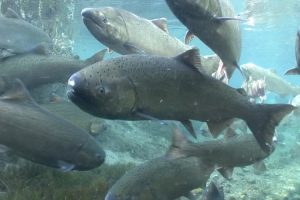Federal Government Assumes Management of Salmon Fishing in Parts of Cook Inlet
Salmon fishing in the federal waters of Cook Inlet will restart this summer with a shift in management to the federal government, as finalized in a recent ruling. The National Marine Fisheries Service (NOAA Fisheries), a branch of the National Oceanic and Atmospheric Administration, is assuming control over salmon management in the inlet waters categorized as the federal exclusive economic zone, extending beyond 3 miles offshore. This new regulation becomes effective on May 30th.
Up until this point, the state had overseen salmon fisheries in both state and federal waters of the inlet. However, due to a decade-long legal battle, federal courts mandated a shift in management. The United Cook Inlet Drift Association (UCIDA), comprising commercial salmon fishermen, initiated legal action against the federal government in 2013, alleging a failure to formulate a salmon harvest management plan for the federal waters of the inlet. Instead of crafting a specific plan for Cook Inlet salmon, the National Marine Fisheries Service had relied on the Alaska Department of Fish and Game, which historically managed salmon harvests across the inlet in both state and federal waters since statehood.
The UCIDA lawsuit challenged state management decisions, alleging that the National Marine Fisheries Service was neglecting its responsibilities. In 2016, the 9th U.S. Circuit Court of Appeals sided with UCIDA.
In 2021, another UCIDA lawsuit arose when the North Pacific Fishery Management Council attempted to shut down salmon fishing in federal waters while a new management system was established. Despite this effort, federal waters remained open under temporary state management.
Under the new regulations, individuals harvesting salmon in federal waters, as well as processors and buyers handling such salmon, must obtain new federal permits. Additionally, the regulations prohibit harvesting in both federal and state waters on the same day, limit the use of multiple nets, and impose stricter documentation requirements for catches, among other stipulations.
A map illustrates the federally controlled exclusive economic zone within Cook Inlet, marking the region where the federal government has assumed management of salmon fishing, a departure from decades of state oversight spanning the entire inlet. (Map provided by the National Oceanic and Atmospheric Administration/National Marine Fisheries Service)
Fractured salmon management in Cook Inlet due to litigation has raised concerns among various stakeholders, including federal authorities. The North Pacific Fishery Management Council, at its April meeting, declined to adopt any management alternatives for federal waters, citing disparities with their existing system and federal agencies’ lack of capacity for precise, in-season salmon management.
The Alaska Department of Fish and Game declined co-management with the federal government, expressing concerns about the federal system’s operational model, particularly its reliance on preseason forecasts for setting catch limits.
Gary Harrison of the Chickaloon Village Traditional Council sees a potential silver lining in federal management, offering Indigenous harvest opportunities. However, he criticized the forthcoming federal management plan for its dependence on historical data and lack of real-time adjustment mechanisms.
The National Marine Fisheries Service acknowledges the complexities of Cook Inlet salmon fisheries in its final rule announcement, conceding that uncertainties in management are inevitable.
 Maritime Injury Law Blog
Maritime Injury Law Blog


